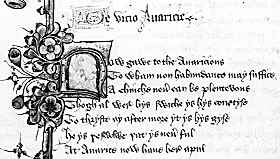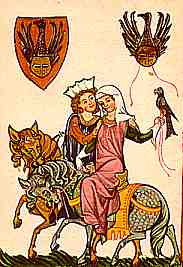


If you are looking at this page without frames, there is more information about medieval writing to be found by going to the home page (framed) or the site map (no frames).
| Works on Gentlemanly Pursuits (3) | ||
| In the tumultuous medieval times, circumstances often meant that aristocratic men came to positions of might and power at a young age. Manuals for the behaviour of princes and magnates were presumably commissioned, and their contents dictated, by nervous older men of might rather than by the presumptuous poets who composed and presented them. It is not hard to imagine what a hot blooded young prince might have thought of being presented with a lavish volume on how to behave himself and be a wise and proper leader by some mothy poet, with all the old guys of the court scowling approval, but he had to accept it graciously. | ||
 |
Segment from aa early 15th century manuscript of Thomas Hoccleve The Regement of Princes (British Library, Arundel 38, f.81), by permission of the British Library. | |
| The sample above concerns the vice of avarice, and comes from what is probably the presentation copy of the work to the young Henry V when he was still Prince of Wales. Well, he did give up tennis and go on to reconquer France, so perhaps it helped. | ||
 |
||
| A depiction of dining from the 14th century Luttrell Psalter. | ||
| Works which percolated down the social scale, teaching the aspiring upwardly mobile gentry and their offspring how to behave in polite society, and particularly at meal times which were the great occasions for social display, were produced in the form of courtesy books. Even cookery books of the late medieval period were more about understanding the complex social rituals of dining than they were about how to whip up something tasty for a family dinner. Like other books of practical knowledge for the upper classes, they were for the library not the kitchen, and had serious overtones of social obligation and ritual. | ||
| For more information about these works, see the section on Works on Food and Cookery on the website. | ||
| You may have noticed that several of the pretty coloured illustrations in this section have been taken from illustrations in the Manesse Handschrift, a 14th century work of lyric poetry. This perhaps emphasises the point that the writing of such poetry was itself considered to be an aristocratic accomplishment, whatever its origins in the works of rambling troubadours and somewhat offbeat wandering clerics. The poetry itself was supposed to embody the values of chivalry and courtly love, both of which may have been a bit dubious in practice, but we won't go there right now. The fancy volumes of poetry themselves contain the significata of rank and the depiction of aristocratic values. | ||
 |
The images in the Manesse Hanschrift are all idealised representations of the aristocratic poets of the collection. The example at left shows several of their upper class attributes, from the heraldic badges to the fine horses and the lady's hawk on her wrist, and a little bit of courtly smooching. And let us not forget the text of the work, the lyric poetry, itself indicating that literacy itself was an upper class attribute. | |
| An aristocratic author and his lady love, in an illustration from the Manesse Handschrift, a 14th century volume of German lyric poetry. | ||
| By the later middle ages, the wealthy gentleman could own a library of valuable prestige works, some of which related to his aristocratic lifeways and reflected on his social worth. For this, he had to accept a certain amount of preaching and instruction for the good of his mortal soul and for the benefit of his judgment and worth as a manager and leader. Perhaps this was not such a bad system. | ||
|
|
||
|
If you are looking at this page without frames, there is more information about medieval writing to be found by going to the home page (framed) or the site map (no frames). |
||